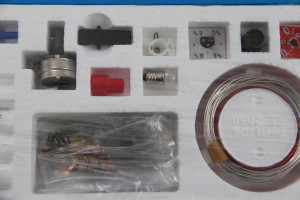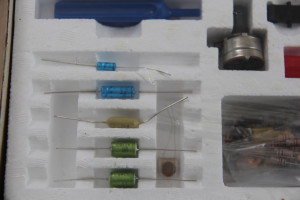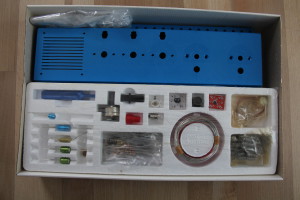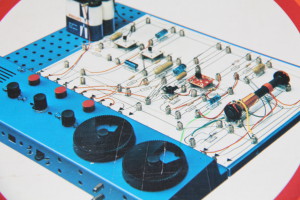![]()

Another electronics kit from my youth is the Philips EE series. It dates approximately to the years 1976-1979. The box presented here is the EE2050. Unfortunately, this is no longer the original that I recorded back then, but a version bought on eBay. But this is a real collector’s item, because the box has never been recorded.
The boxes (EE2003 / 41/50/51/52) under my custody have unfortunately not survived the years. Since the modular system was designed in such a way that all components were “free”, ie not riveted to any sockets (just as they were also used in industry), I always used them. If I needed a resistor or capacitor quickly, the kit had to serve as a “donor”.

The concept of the modular system: It consists of a perforated plastic base plate through which a hairpin spring is inserted. This hairpin spring in turn holds a spiral spring. Now, between the hairpin spring and the upper end of the coil spring, the connection wire of the component can be clamped.

The components themselves are contained in the box as they are also commercially available. An exception here are only the transistors and transformers. They are mounted on a small printed circuit board, which facilitates assembly and also protects the component itself from mechanical stress.
In the final stage, the box consists of two bolted base plates, which in turn are bolted to a control panel. In this media console then turn capacitors, rotary potentiometers, buttons, bulbs and a speaker place. The number of experiments to build is also huge. The manuals are very well structured. They describe the basics of DC technology, as well as the operation of the circuits.
Here is an excerpt from the inscription of the electronics box. Note the gender-oriented spelling 🙂
Wonderful world of electronics – a mysterious world that every boy wants to get to know and understand. This electronic kit gives him the opportunity to easily gather his own insights in this field. The box contains a richly illustrated instruction book and over 150 items – e.g. 10 resistors, 5 capacitors, photocell and transistors. Thanks to the clamping system, the young electronics builder can assemble these parts completely independently and without prior knowledge to the following functional devices:
Burglar Alarm Systems, Amplifiers, Automatic Parking Lights, Humidity Indicators, Acoustic Relays, Morse Exercise Machines, Brightness Controls, Timers, Others – a total of 21 electronic devices and many interesting circuits.
With additional boxes the possibilities extend to the MW radio with loudspeaker. Proper engineers work with the same parts: all the boxes in the Philips Elektronik series are equipped with the most modern parts of today’s electronics in their original form.










